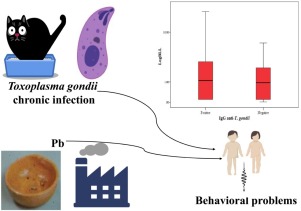当前位置:
X-MOL 学术
›
Neurotoxicology
›
论文详情
Our official English website, www.x-mol.net, welcomes your
feedback! (Note: you will need to create a separate account there.)
Interaction of Toxoplasma gondii infection and elevated blood lead levels on children's neurobehavior.
NeuroToxicology ( IF 3.4 ) Pub Date : 2020-03-19 , DOI: 10.1016/j.neuro.2020.03.010 Victor O Martinez 1 , Fernanda W de Mendonça Lima 2 , Rômula B Alecrim Rocha 3 , Homegnon A Ferréol Bah 3 , Chrissie F Carvalho 4 , José Antônio Menezes-Filho 5
NeuroToxicology ( IF 3.4 ) Pub Date : 2020-03-19 , DOI: 10.1016/j.neuro.2020.03.010 Victor O Martinez 1 , Fernanda W de Mendonça Lima 2 , Rômula B Alecrim Rocha 3 , Homegnon A Ferréol Bah 3 , Chrissie F Carvalho 4 , José Antônio Menezes-Filho 5
Affiliation

|
A chronic infection caused by Toxoplasma gondii was considered asymptomatic in immunologically healthy humans, but results from animal and epidemiological studies led to a reconsideration of this assumption. The objective of this study was to evaluate the seroprevalence of T. gondii infection and its possible effects on the behavior of school-aged children in Bahia, Brazil. Serum anti-body determinations were performed by Enzyme-linked Immunosorbent Assay (ELISA). Blood lead levels (BLL) were measured by graphite furnace atomic absorption spectrometry (GFAAS). The evaluation of a child's behavior was assessed using the Child Behavior Check List (CBCL). Multivariate models applying logistic regression were used to test the association of chronic T. gondii infection and BLL with behavioral outcomes in children. Seroprevalence for anti-T. gondii IgG antibody was 43.7 % (95 %-CI: 35.8-51.9). Significant associations between chronic T. gondii infection and total behavioral problems (OR = 2.50; 95 %-CI: 1.06-5.88), internalizing spectrum problems (OR = 4.35; 95 %-CI: 1.11-17.14) and rule breaking (OR = 2.61; 95 %-CI: 1.12-6.05) were observed. A possible interaction between toxoplasmosis prevalence and lead exposure was detected. Children with above the median BLL and positive for IgG anti-T. gondii showed a 5.51-fold increase (95 %-CI: 1.75-17.38) in the chance of displaying disobedient behavior. The results suggest that T. gondii infection may be contributing to the high indices of behavioral changes. Moreover, these findings are the first evidence for a possible interaction between chronic T. gondii infection and elevated blood lead levels on children's neurobehavior.
中文翻译:

弓形虫感染与儿童神经行为中血铅水平升高的相互作用。
在免疫学健康的人类中,弓形虫引起的慢性感染被认为是无症状的,但是动物和流行病学研究的结果导致人们重新考虑了这一假设。这项研究的目的是评估弓形虫的血清阳性率及其对巴西巴伊亚学龄儿童行为的可能影响。通过酶联免疫吸附测定(ELISA)进行血清抗体测定。血铅水平(BLL)通过石墨炉原子吸收光谱法(GFAAS)测量。使用儿童行为检查表(CBCL)对孩子的行为进行评估。应用logistic回归的多变量模型来检验慢性弓形虫感染和BLL与儿童行为预后的关系。抗T的血清阳性率。刚地IgG抗体为43.7%(95%CI:35.8-51.9)。慢性刚地弓形虫感染与总体行为问题(OR = 2.50; 95%-CI:1.06-5.88),内在频谱问题(OR = 4.35; 95%-CI:1.11-17.14)和违反规则(OR =观察到2.61; 95%CI:1.12-6.05)。弓形虫病患病率和铅暴露之间可能存在相互作用。BLL中位数以上且IgG抗T阳性的儿童。刚地犬表现出不服从行为的机率增加了5.51倍(95%-CI:1.75-17.38)。结果表明,刚地弓形虫感染可能是行为改变的高指标。此外,这些发现是慢性弓形虫感染与儿童神经行为血铅水平升高之间可能相互作用的第一个证据。
更新日期:2020-03-20
中文翻译:

弓形虫感染与儿童神经行为中血铅水平升高的相互作用。
在免疫学健康的人类中,弓形虫引起的慢性感染被认为是无症状的,但是动物和流行病学研究的结果导致人们重新考虑了这一假设。这项研究的目的是评估弓形虫的血清阳性率及其对巴西巴伊亚学龄儿童行为的可能影响。通过酶联免疫吸附测定(ELISA)进行血清抗体测定。血铅水平(BLL)通过石墨炉原子吸收光谱法(GFAAS)测量。使用儿童行为检查表(CBCL)对孩子的行为进行评估。应用logistic回归的多变量模型来检验慢性弓形虫感染和BLL与儿童行为预后的关系。抗T的血清阳性率。刚地IgG抗体为43.7%(95%CI:35.8-51.9)。慢性刚地弓形虫感染与总体行为问题(OR = 2.50; 95%-CI:1.06-5.88),内在频谱问题(OR = 4.35; 95%-CI:1.11-17.14)和违反规则(OR =观察到2.61; 95%CI:1.12-6.05)。弓形虫病患病率和铅暴露之间可能存在相互作用。BLL中位数以上且IgG抗T阳性的儿童。刚地犬表现出不服从行为的机率增加了5.51倍(95%-CI:1.75-17.38)。结果表明,刚地弓形虫感染可能是行为改变的高指标。此外,这些发现是慢性弓形虫感染与儿童神经行为血铅水平升高之间可能相互作用的第一个证据。











































 京公网安备 11010802027423号
京公网安备 11010802027423号